#New International Readers Version Bible
Explore tagged Tumblr posts
Text

Do Not Envy Sinners
Don’t be upset because of sinful people. Don’t be jealous of those who do wrong. — Psalm 37:1 | New International Reader’s Version (NIRV) Holy Bible, New International Reader’s Version® Copyright © 1995, 1996, 1998 by Biblica. All rights reserved worldwide. Cross References: Psalm 37:7; Psalm 73:3; Proverbs 3:31; Proverbs 23:17; Proverbs 24:1; Proverbs 24:19
#admiration#envy#sinful lifestyle#materialism#wrongdoers#wicked men#Psalm 37:1#Book of Psalms#Old Testament#NIRV#New International Readers Version Bible#Biblica Inc.
11 notes
·
View notes
Text
New International Reader's Version Bible (NIrV) Updated
New International Reader’s Version Bible (NIrV), Updated What Is It? The YouTube video New International Reader’s Version Bible (NIrV), Updated by the YouTube channel Zondervan, which is about the New Internation Reader’s Version (NIrV) bible translation: New International Reader’s Version Bible (NIrV), Updated Description: The New International Reader’s Version (NIrV) is a version of the…
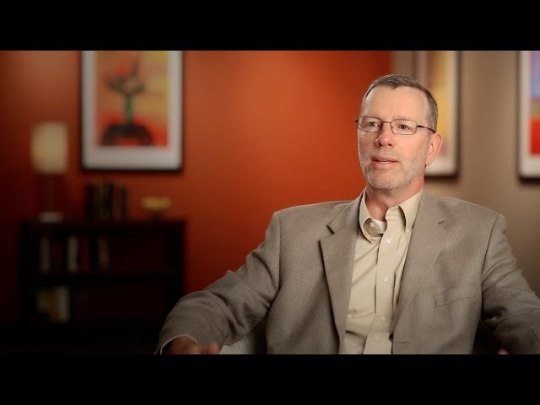
View On WordPress
#Bible#Bible Translation#Christian Bible#New International Reader&039;s Version#New International Reader&039;s Version Bible (NIrV) Updated#New International Version#NIrV#NIV#The Bible#Translation#Video#YouTube#Zondervan
0 notes
Text
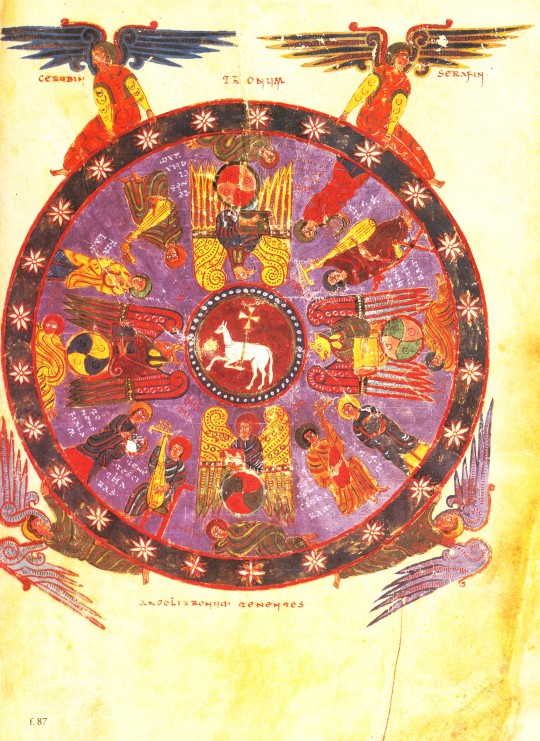

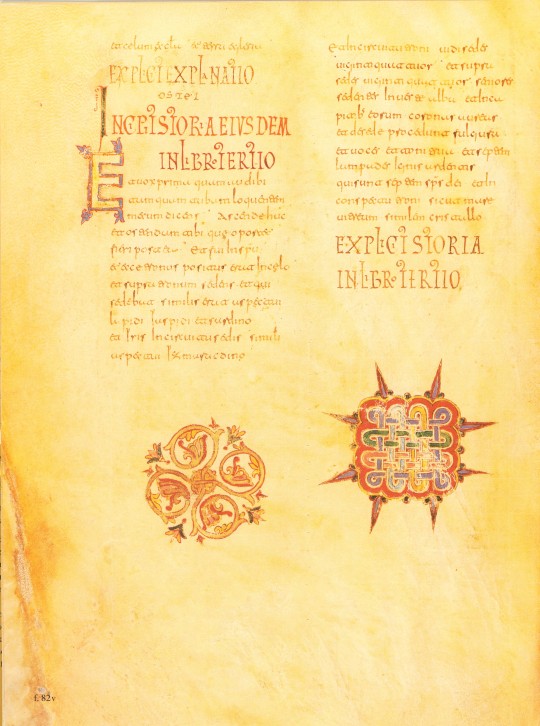
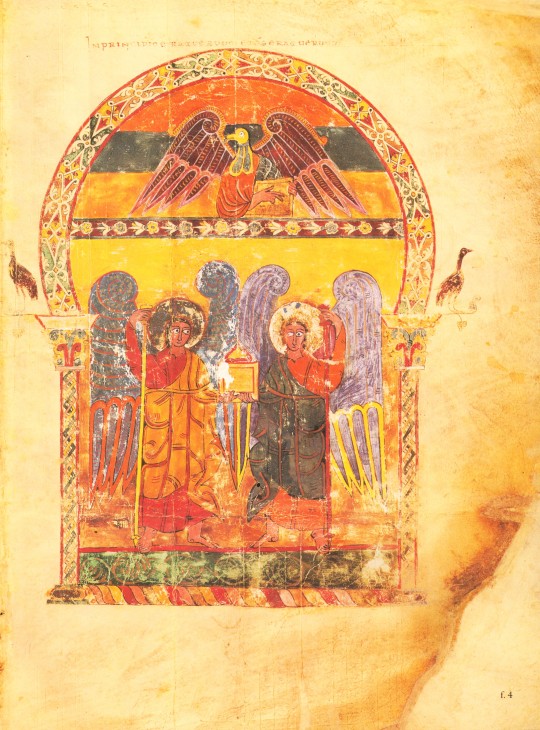




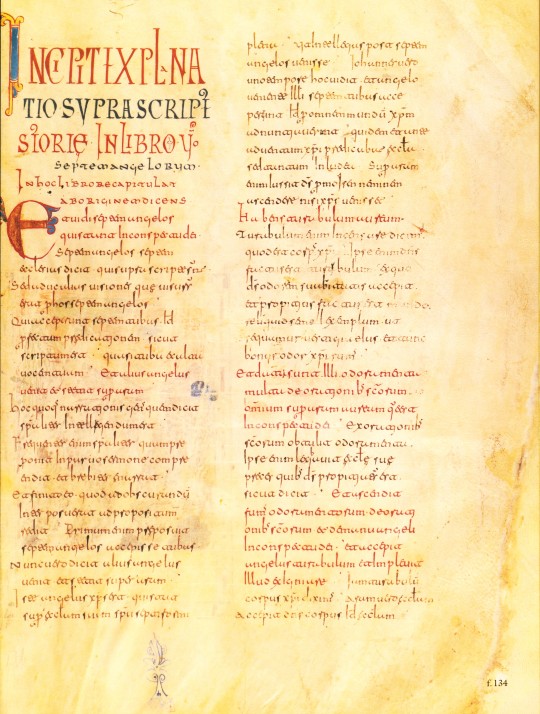
Welcome to Manuscript Monday!
In this series we will periodically focus on selections from our manuscript facsimile collection. Today we present selections from the Morgan Beatus Manuscript, reproduced as A Spanish Apocalypse, The Morgan Beatus Manuscript in New York by George Braziller, Inc. in association with the Pierpont Morgan Library in 1991. The original manuscript, made around 10th century CE at the scriptorium of San Miguel de Escalada in Spain by a monk named Maius, is the earliest surviving illuminated version of the monk Beatus of Liébana's commentary on the biblical Book of Apocalypse (also known as the Book of Revelation). The text of the Book of Revelation makes up the first part of the manuscript, and Beatus’s commentary comprises the second part. The Book of Revelation tells of the end-times in Christianity, during the final judgement of humanity by God. The story within this Biblical book was also seen by those living during the Latin medieval era as representative of the beginning of something new: God’s celestial kingdom. Due to this view of the book, many artists incorporated imagery from this part of the Bible in their work.
Produced in Al-Andalus, or Muslim-ruled Spain, the artistic style of this work combines both Muslim and Christian visual traditions to create a beautifully illuminated manuscript that supplements the commentary by the monk. This artistic style is known as the Mozarabic, which comes from the Arabic mustaʿrib, meaning ‘Arabicized’. Interestingly, this style of art can only be seen in Christian religious art and architecture from Spain at the time, as non-religious artistic objects made by Christians look so similar to Islamic versions of the same works that they cannot be identified as intentionally Christian. Some key Islamic artistic elements within the manuscript include buildings with horseshoe arches, intricate geometric and vegetal patterns as borders for larger images, and the large, bulging eyes of the illustrated animals.
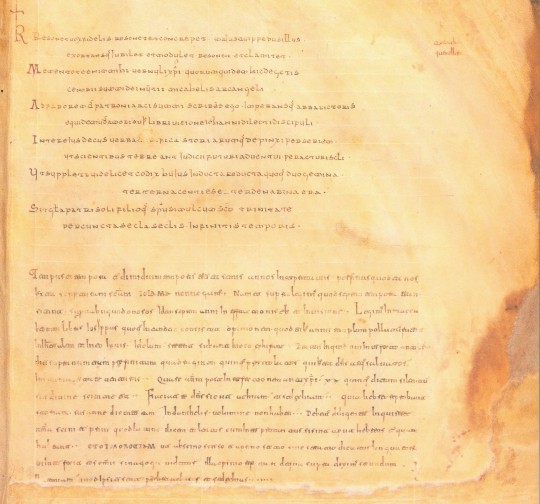
Another interesting aspect of this specific manuscript is the colophon at the end of the manuscript. It tells readers about the circumstances surrounding the creation of this book, including the maker, the patron, the year it was made, and an explanation about why Maius created the manuscript ("I write this . . . at the command of Abbot Victor, out of love for the book of the vision of John the beloved disciple. As part of its adornment I have painted a series of pictures . . . so that the wise may fear the coming of the future judgement of the world's end."). Colophons in medieval manuscripts are not usually as detailed, so the inclusion of all this information contributes greatly to the knowledge and history surrounding the Morgan Beatus Manuscript.
View more Manuscript Monday posts.
– Sarah S., Special Collections Graduate Intern
#manuscript monday#manuscripts#morgan library#morgan beatus manuscript#Beatus of Liébana#Spain#Christian art#Mozarabic#Islamic art style#facsimilies#Spanish art#Medieval art#Spanish medieval art#A Spanish Apocalypse#George Braziller#illuminated manuscripts#Sarah S.
140 notes
·
View notes
Note
I'm super-new to this, how many english translations are there? Which one should I read as a first-time reader? I'm sorry if people've already asked you this
There are over a hundred translations of the Bible into English and over three thousand total for all languages.
The most common ones used are
King James Version (The one I use)
New International Version
New Revised Standard Version
As far as which one to start with? I would say the one that you can understand the best. Though it is fun to read KJV out loud because you sound like a Shakespearean actor
32 notes
·
View notes
Text
a little fun fact about me is that i bathe in religious imagery and motifs, and i will eat them up in every media as long as portrayed properly. this is a quote from the novel and a verse from the bible itself that i put against each other for the sake of compare and contrasting for the people. if you dislike this content, simply leave :)
warning(s): UNDER THE CUT IS A SPOILER FOR ORV, PLEASE READ AT YOUR OWN RISK, bible verse, religious motifs, WORDS, introspection, a reader's viewpoint :)

[There are three ways to survive in a ruined world. Now, I have forgotten a few, but one thing is certain. The fact that you who are reading these words will survive for sure. ] —Chapter 1: Prologue, Omniscient Reader's Viewpoint
Revelation 1:3 NIV (New International Version)
Blessed is the one who reads aloud the words of this prophecy, and blessed are those who hear it and take to heart what is written in it, because the time is near.
-
i find it so fascinating to see a lot of chapters from the bible presented through media in forms of religious imagery and motifs is still present to this day. maybe its because its intimate to reference back to the day of creation and the day of doom, in some way people can also relieve religious trauma one might've experienced, maybe i'm even looking into this too much making it farfetched and its just the predictability of humans creating and writing similar stories.
still, i like to find references in the different media i consume. its not just fun to compare and contrast ideas, it helps sparks curiousity within me and make a possible study case. y'know, the fickle nature of humans and filling their curiosity to the brim, needing to find an answer deeper than things just being simple !
anyways, this is just a drabble or what i'd like to call a reader's viewpoint.
hoped you enjoyed this silly read :)

#arbiter.secrets#orv#omniscient reader spoilers#omniscient reader's viewpoint#omniscient reader#omniscient readers viewpoint#orv kdj#orv kim dokja#orv yjh#orv yoo joonghyuk#orv hsy#orv han sooyoung#this is my orv post for the night#kim dokja#yoo joonghyuk#han sooyoung
13 notes
·
View notes
Text
Who is Jesus of Nazareth?
A Devotional Study of the Gospel of Mark
Mark 4:30-32 — Nothing Like It
By xapitos. All rights reserved. 2023.
Introduction
This study of the Gospel of Mark from the Christian Scriptures follows the premise to take a book at face value. This is a common practice for books. Thus, this study will look at the historical, cultural, archaeological and grammatical context of Mark’s Gospel to see if it truly is what it claims to be, namely the words of the God of the Hebrews, without any errors and final in authority to all that it speaks, claiming that Jesus of Nazareth is the Christ, the Messiah of Israel, who shall deliver his people, and the world of mankind from our rebelliousness against the holy LORD of Israel, King of the universe. If errors are discovered, then the Gospel of Mark will be assumed to be false. Until such a discovery, the book is accepted at face value.
I translate the Gospel of Mark from its Greek manuscripts and follow the paragraph divisions of The Greek New Testament, Third edition by the United Bible Societies. Thus, my Scripture reading may vary from yours here and there in small details. The Hebrew Scripture references are from the Masoretic Text of the Hebrew Scriptures in the Biblia Hebraica Stuttgartensia edition of the Masoretic Text. The Masoretic Text was copied by Hebrew scribes about 1000 A.D. and has been substantiated by various Hebrew manuscripts, the Dead Sea Scrolls, and the Septuagint (dated third to second centuries B.C.), which is the Greek translation of the Hebrew Scriptures. The English version of the Holy Bible used in this study is the New International Version, known as the NIV.
It is necessary to say a word about the translation of the Greek text. I intentionally translate the Greek as it is written, not smoothing out the English translation, as is done in English Bibles based on the original biblical languages of Hebrew, Aramaic, and Koine Greek. At times, the translation will come across awkward, wooden, and repetitive in English. Translating from one language to another can appear this way. Another involved factor is that it is obvious that God wrote the New Testament the way he did to emphasize what he wanted to emphasize through the Greek grammar and sentence structure. Without translating this way, such divine emphases might be missed by the English.
It is interesting to note, to me at least, that Mark continues to use the conjunction “and,” at the beginning of almost every clause. Some might call this poor grammar. I call it a “child’s heart.” Remember when your children were (or are) young and when they became excited, they just talked and talked, almost without breathing? This is what Mark’s continual use of “and” shows me. He is so excited about Jesus and his story, that it appears that he cannot wait to tell us everything he learned from the apostle Peter (Simon) about Jesus. May each of us have such a child’s heart.
Study
Mark 4:30-32 (30) And he was saying, “How shall it be likened the kingdom of God, or with what parable shall we describe it? (31) Like a mustard seed, which when it is planted in the earth, the smallest of all the seeds which are in the earth, (32) and when it grows, it ascends and becomes the greatest of all of the garden herbs and makes a shadow great, so that to be able under the shadow of it the birds of heaven dwell.
(30) And he was saying, “How shall it be likened the kingdom of God, or with what parable shall we describe it? This is the fourth parable Jesus speaks to describe the Kingdom. The Kingdom is so important to the Messiah and to God that they take four short parables in a row to describe it. Whenever the Lord repeats something in the Bible, it is done for emphasis to the listener/reader. In other words, the Kingdom of God is God’s emphasis to us. Pay attention! This is of eternal importance for your eternity and mine.
(31) Like a mustard seed, which when it is planted in the earth, the smallest of all the seeds which are in the earth, (32) and when it grows, it ascends and becomes the greatest of all of the garden herbs and makes a shadow great, so that to be able under the shadow of it the birds of heaven dwell. Jesus picks the smallest of the garden seeds used in his day. Some try to use this passage to show that Jesus made a mistake and was ignorant. Not so. The context is always the guide to understanding Scripture. The context here is gardening (not flower gardens) for the purpose of growing food. This is the fourth agrarian related parable describing the Kingdom of God. It is not a study about the smallest seed on the planet. Secondly, it was common proverbial speech in Jesus’ day, and before his day, to use the mustard seed as a figure of speech to describe something small. This usage appears in the Mishnah and the Talmud (Jewish writings and interpretations of the Hebrew Scriptures). Thus, our parable in question has a clearly cultural form of interpretation that dated to before the time of Jesus (Biblical Historical Context, “The smallest of all the seeds” biblicalhistoricalcontext.com/hermeneutics/the-smallest-of-all-the-seeds/). Thirdly, those who say that Jesus made a mistake by saying that the mustard seed is the smallest of all seeds have not taken into account the possibility (a very plausible one) that the seeds in existence now are different than the seeds of his time. In other words, macro-evolution (Answers in Genesis, “Are Mustard Seeds the Smallest or Was Jesus Wrong?, by Harry F. Sanders III, August 4, 2018, answering genesis.org/bible-questions/are-mustard-seed-the-smallest-or-was-Jesus-wrong/). Thus, there is the contextual explanation of the agrarian context and the proverbial context, with which Jesus and his contemporaries were very familiar, as well as the very possible macro-evolutionary context, that we are more familiar with, and lastly, parables are a form of communicating a literal idea. They use figures of speech and cannot be forced to be literal in every point. The main idea of any parable is the literal point being communicated. Just ask a poet.
The conclusion is that Jesus’ parable is safe and accurate to which he was speaking, namely the Kingdom of God, and neither crumbles by a modern, scientific interpretation from our time being forced upon this passage.
(32) and when it grows, it ascends and becomes the greatest of all of the garden herbs and makes a great shadow, so that to be able under the shadow of it the birds of heaven dwell. Verse 32 gives us the main idea of this parable: the Kingdom of God is large enough for all to live in and enjoy its place of rest, structure and existence. As a large mustard tree casts a big shadow that all the types of birds can enjoy and in which they find shelter from the sun, rain, wind and storms, so the Kingdom of God is large enough for all humans, male and female, black, yellow, white, brown, to enjoy and live in.
Self-reflection
How are you communicating about the kIngdom of God to others in your life?
Are you living out the Kingdom of God in the way that this parable communicates, namely, to cast a very large Kingdom of God shadow, in which any human can find spiritual rest, peace, safety, and well-being?
What can you do to improve in yourself the above concepts and the Kingdom of God lifestyle reflected in your answers?
7 notes
·
View notes
Text
Liberation’s Option

Ever bought those nice finds in rummage shops for a cheaper price? But once you unpack it at home, you suddenly realize that it was already without the full package of the original? I myself once found a good pair of sneakers ‘on sale’ but minus the original shoestrings. Obviously, it made me think twice whether I should settle for the bargain and just live with what was lacking. In today’s marketplace of Christianity, one would also encounter similar versions of theological goodies on sale. The price tag may come appealing but what you might get is wanting upon closer inspection.
A case for example, do a careful re-reading of the Bible and it shall make today’s popular offer of salvation, i.e., “your soul’s chance of migrating to heaven,” look like no different from those rundown goods on a markdown sale.[1] This blunt comparison has to be made considering that God’s plan of redemption, that is, his mission of renewing all that He has made, includes the planet, its people, and their pattern of life. That is, today’s devastated creation, polluted rivers and corrupted human beings alike, including the deteriorating cultures and civilizations that thrive within it are all objects of God’s liberating mission. [2]
I came upon this observation upon realizing that the Bible speaks of salvation as the full restoration of all aspects of life in the world, exactly as God has sketched it from the very beginning.[3] A blueprint of this plan can be found in the initial pages of the book of Genesis.[4] In it, the writer presents a picture of a life wherein God and humanity were happily together, in a beautiful dwelling place, and with a pattern of relationship marked by trust, nurture, and joy. The Hebrews of old have a term for this particular way of life characterized by remarkable harmony – ‘shalom.’ Repeatedly, their prophets speak of a dream and a hope that is no less beautiful (see for example: Isaiah 65:17-25, Jeremiah 31, Micah 4).
Shalom is simply the Old Testament’s planetary vision for what in the New Testament was often referred to as God’s gift of ‘salvation.’ But make no mistake about it, the apostles Peter, John, and Paul have in mind a notion of redemption that is as equally comprehensive as that of Isaiah and Jeremiah.
The Victory of Christ. For an instance, Apostle Paul in Colossians 1:20 speaks of how God, through Christ and by His work on the cross, is reconciling “all things” in heaven and on earth back to Himself.[5] In this verse, the apostle to the Gentiles was alerting his readers at the city of Colossae that until then all of these things have been snatched away from God. And indeed, for a time, the whole world was in the clutches of the Evil One who has sought to steal all that was in it, drain it of its life, and ultimately cause its destruction (John 10:10). But this is not because this fiendish being has proven to be stronger than God and has actually prevailed against Him. No! It is simply because he has effectively triumphed over creation’s designated ruler and steward -human beings. To put it in contemporary terms, the Evil One laid siege on God’s earth, held its human rulers and inhabitants hostage, and terrorized what he was able to capture with his flag firmly planted in their hearts and homeland.[6]
How such terrorism of God’s creation happened is a loop that repeats itself throughout human history. But Genesis 1-3 unlock to us the internal mechanism of how this subtle infiltration works out. It tells a story of how the Serpent tricked the newly weds Adam and Eve and managed to subdue them under his will. By listening to the Enemy’s lies, the couple threw away God’s wonderful plan for their lives which is to be the world’s rightful ruler and caretaker (Gen. 1:27-27, 2:15). In effect, they exchanged God’s royal image in them (as prince and princess) for a lowly status of a refugee and a vagabond. Thereafter, the Evil One and his minions presented themselves as ‘gods’ and ‘rulers’ of this world (II Cor. 4:4, John 12:31, Ephesians 2:2). Later on, the Evil One even got the nerve to bribe God’s own Son in the flesh with all of the world’s riches and glory (which he claims to be his) in exchange for an undivided allegiance to him (Matt. 4:8-10).
But God’s Son knew better. He knew that His Father is launching a take-over project. That he was sent with a messianic mission of reclaiming control of all that which his Father has created, away from the clutches of the Evil One, and restore it to its rightful rulers. As John understands it, God’s Son was sent for the specific purpose of destroying the devil’s work (I John 3:8). Apostle Paul in Colossians 2:15 talks of how God’s Son has disarmed the Evil One and his minions of their powers. In his letter to the church at Ephesus (Eph. 4:8-10), he added how God’s Messiah has so effectively triumphed over them and that he succeeded in giving back to human beings their royal identities (Eph. 2:6, Col. 3:4). By a swift execution of this covert operation, the power of the Evil One has been broken, or as CS Lewis puts it in his famous novel, the grim spell of dark magic casted by the Great White Witch has been undone, at Aslan’s slaying at the Stone Table, and thereafter, Narnia and the Narnians were free again.[7]
Liberating the Planet. Apostle Paul writes in Romans 8 that the natural environment “groans in pain” as its await its liberation from decay in as much as humanity struggles to be set free from whatever it is that enslaves it whether selfishness, sickness, or even death itself.[8] The outpouring of God’s Spirit in people’s hearts (Ezek. 36:25-27), and the remarkable personal and social transformation that comes with it, is the earth’s assurance that one day it shall also see its own light of day. That is, liberated from the curse of devastation, the earthly realm shall once again be in full bloom. Apostle Peter speaks of God’s purifying fire that shall render the old heavens and old earth no more to usher in a new world (II Peter 3:12-13). The final picture was painted with more vivid details by Apostle John in his apocalyptic book (aka the Revelation). In its final chapters, he wrote down his vision of a new city of Jerusalem coming down from the heavens into a new earth. And he saw God dwelling with human beings once more in a place where there shall be no more tears, or pain, or sickness (Rev. 21:1-4).
Liberating its People. It is with this planetary renewal that the New Testament also pictures the promise of our bodily resurrection.[9] God’s work of transforming human beings into a new creation (Col. 3:10) does not stop with a renewal of personal morality and social relationships (Col. 3:5-11), not even with the security of one’s soul (I Peter 1:9). It includes, perhaps, most importantly, a promise of gaining a physical body free from imperfections and decay and death itself, exactly as the one Christ himself carried with him when he rose from the grave. Paul explains that as citizens of an new eternal city, its inhabitants shall need a new body that would be as equally glorious (I Cor. 15:35-55). If anything, this belief in bodily resurrection sets the early church’s understanding of salvation as sharply opposed to that of their Greek culture they inhabit which thinks of salvation as the liberation of the soul from the body.
While this hope of bodily redemption can easily be taken for granted by the average person, it is definitely good news for those who suffered from blindness and other physical ailments. That the lame can one day run and swim again, and that those born deaf can hear the most beautiful of Mozart’s musical composition shall be a most splendid news for those who went through life bereft of such simple joys. That this new body defies even the threat of death as well only means that the joys of life in the new heavens and new earth is something that human beings will enjoy with God not only for a limited moment but for eternity.
Liberating their Patterns of Life. As mentioned already, selfishness is part of what Christ has set human beings to be free of. This particular trait cuts across both the vertical and horizontal dimensions of human relationships. This is because what is commonly regarded as ‘sinful’ acts are basically manifestations of a disposition of the heart and attitude of the mind that have no regard for the will of God and the welfare of other people. The so called problem of sin, at its very core, is an issue of idolatry at one level and apathy on another.[10] That is, the relentless turning of one’s desire to godlike proportions and putting one’s personal interest to the disregard (and in many times, to the detriment) of another human being. All the horrors of humanity, corruption and injustice in government, abuses and oppression in society, etc. can be rooted in this twin habits of the human heart.
In its place, Christ left the world with a way of living that mashes-up one’s love for God and one’s love for neighbor as two inseparable sides of the same coin (Luke 10:25-37).[10] At the cross, he exemplified what it means to live a life of sacrificial love (John 15:14, I John 3:16).[12] All who are to be called his disciples are enjoined to follow in his footsteps and live a life of compassion, forgiveness, and humility.[13] Christ spelled out how this pattern of life works out in everyday life most specifically in what is now called as the “Sermon on the Mount.”[14] Simply stated, to live a life that is godly is to be a good neighbor to all people, especially those mostly in need. This pattern of Christlike living has not only confronted but also influenced cultures and civilizations on what it means to look after the less fortunate and how to look upon and treat those pushed at the margins of society.[15]
Conclusion. This brief sketch of a possible re-reading of key passages in the New Testament shows that at the heart of what God sought to accomplish in history may well be about the liberation of life for all of His creation -the bees, the birds, your neighborhood and its cultural practices, including the rivers and hills in which it is located (Acts 17:26). Perhaps, this musing can provide an alternative for those coming out shortchanged as they look for what salvation is all about in today’s shopping complex of Christian goodies.
-Rei Lemuel Crizaldo (originally posted December 2017 at the Micah Global blogsite)
NOTES:
[1] This soteriological notion is reflected in popular Gospel presentations such as Evangelism Explosion (EE), Simplified Bridge Illustration, the Roman Road, and even in what is called as “The Wordless Book.” By the way it formulates the Good News, it also necessarily reduces the concept of salvation as finding the solution to the problem of sin and its punishment (the fires of hell) by securing the destiny of one’s soul in heaven. But as Prof. John Stackhouse Jr. of Regent College reminds us, “An understanding of salvation that amounts to a sort of spiritual individualism is little better than Gnosticism.” This is why he thinks there is a need to “redouble our efforts to teach what the Bible teaches about salvation in all its glorious complexity and scope” and“prod evangelical theology toward a vision of salvation as large as God’s mission to the world He loves and redeems” (see the book he edited, “What Does it Mean to Be Saved? Broadening Evangelical Horizons of Salvation” published by Baker Academic in 2002). This blogpost is a humble contribution to such a clarion call.
[2] Unfortunately, the term ‘liberation’ has been so rigidly associated (or even, ‘hijacked’) in theological literature as referring to the movement called Liberation Theology developed in Latin America (cf., Gustavo Gutierrez). But the term itself is a rich word that captures a lot of what the Bible says about ‘redemption.’ I am of the opinion, that the word might as well be redeemed from the usual theological baggage associated with it and be given a fresh lease of life. Interestingly, the Micah Global has recently framed its missiological understanding along the lines of ‘liberation’: “Scripture has a ‘liberating’ theme running through it and the climax of the Good News message is one of redemption and restoration. God is our Liberator, not only of humanity, but of all creation… We are to be signposts, demonstrating God’s liberating agenda for his world, proclaiming and pointing to the ultimate liberation of all things in heaven and earth when Christ returns” (cf., Sheryl Haw, Micah Global Inform October 2017 – “God’s Liberating Agenda”).
[3] The works of Old Testament scholars such as Walter Brueggemann (“Theology of the Old Testament”) and Chris Wright (“The Mission of God”), including the works of New Testament theologian NT Wright (initially, his book, “Surprised by Hope”), as well as the numerous articles of Latino missiologist C. Rene Padilla became formative influences in my reflections.
[4] I previously run a series of blogposts on this topic. First post can be found here: http://xgenesisrei.tumblr.com/post/159811395065/lifes-perfect-playbook
[5] Elsewhere, in Ephesians 1:8-10, Paul said that this project of reconciling everything in the heavens and on earth to Christ is God’s “secret plan.”
[6] This led some thinkers such as Greg Boyd to develop an overtly negative picture of the world wherein it has been so-wretched by Satan’s works that God has totally lost control of it. According to him, the whole world has turned into a kingdom of darkness and doom in which God’s people are called by God to set themselves apart. See his book “The Myth of a Christian Nation.”
[7] This storyline is from CS Lewis’ Chronicles of Narnia. But the idea of liberating the world from the dominion of the Evil One is articulated in what is called as the “Christus Victor” theory of the atonement. In essence, this theory highlights the ultimate issue underlying all that is wrong and broken in the world -the cosmic conflict between good and evil in the universe. It focuses on the element that what Christ has accomplished in his earthly mission is to liberate the world from Satan and undo the havoc that he and his demons has wrought upon God’s good creation. Simply said, the problem of humanity is not simply a sin-problem but a more bigger problem of devilish dominion.
It is unfortunate that the individualism and secularism of the Western world, with its skepticism of the paranormal and supernatural beings such as angels and demons, have paved the way for the monopolization in soteriology (theology of salvation) of the atonement theory called as ‘penal-substitution.’ This particular theory teaches that what Christ came to do is to pay for the sins of humanity and serve as their substitute sacrificial offering to appease God’s wrath and let them off the hook of His judgment and punishment in the lake of fire. It fostered a rather narrowed-down idea of redemption as basically an issue of sin-management and at a very personal level.
But the surge of Pentecostalism recaptured the notion of spiritual warfare and the importance of being delivered from the activities of evil demonic spirits. It brought back into the table the neglected dimensions of soteriology that involves the need to free the world not only from penalty of sin but also from the power of Satan.
[8] Paul used in this verse the Greek word ‘eleutheroo’ which means to be set at liberty. Same word used by Paul in Galatians 5:1. ‘To be set free’ is the common translation in English but the picture suggested by the Greek is to possess liberty.
[9] Walter Brueggemann insists that people’s identity are closely tied up to the land they inhabit, even and most especially, the people of God (see his book “The Land: Place as Gift, Promise, and Challenge in Biblical Faith”).
[10] Interestingly, Apostle Paul taught both the believers in Ephesus and at Colossae that greed is basically a case of idolatry (Col. 3:5 and Eph. 5:5).
[11] Elsewhere, Jesus called this two commands as the greatest of all (Matt 22:36-40 and Mark 12:28-34). John the Beloved vividly captured the fusion of the two commands by saying, “If people say, ‘I love God,’ but hate their brothers or sisters, they are liars. Those who do not love their brothers and sisters, whom they have seen, cannot love God, whom they have never seen” (I John 4:20).
[12] It is by laying down this example of giving one’s life for another that Jesus left a new commandment to his disciples in John 13:33. Unlike what he regarded as the greatest of all the commandments in the Old Testament, his new command raises the bar of love for one’s neighbor -no longer just love for one’s self but Christ’s love for the world.
[13] Perhaps, the Old Testament counterpart to this kind of life is what prophet Micah enjoined the Israelites to do as the sum of what Yahweh expects from them: “This is what God requires of you: to do justice, love mercy, and walk humbly with God” (Micah 6:8).
[14] See Matthew chapters 5-7.
[15] Works abound on how the ethical teachings of Jesus have left a deep impact in Western society that in time has embraced Christianity not only as a way of life but also a way of organizing society. See for example Rodney Stark’s “The Rise of Christianity” and Alvin Schmidt’s “Under the Influence: How Christianity Transformed Civilization” and Glenn Sunshine’s “Why You Think the Way You Do: The Story of Western Worldviews from Rome to Home.” On how the early church made such a deep impact to Roman society, see Helen Reese’s “Loving the Poor, Saving the Rich: Wealth, Poverty, and Early Christian Formation.”
3 notes
·
View notes
Text
For those of you curious about Numbers 18:21, the text from the King James Version (KJV) reads:
And, behold, I have given the children of Levi all the tenth in Israel for an inheritance, for their service which they serve, even the service of the tabernacle of the congregation.
Or, in the significantly easier-to-read New Revised Standard Version (NRSV):
To the Levites I have given every tithe in Israel for a possession in return for the service that they perform, the service in the tent of meeting.
That doesn’t mention the “tenth,” but let’s take a look at the New International Reader’s Version (NIrV), where the “tenth” is referenced.
The people of Israel will give me a tenth of everything they produce. And I will give it to the Levites. They serve at the Tent of Meeting. I will give them the tenth for the work they do there.
A few things you might have noticed while looking at those three translations.
The tenth is given to the Levites. Technically, it is given to the Lord, who has granted the Levites control of it. The Levites being the males of the Tribe of Levi, who were entrusted with religious ceremonies. So, um, is Brucie Baby a member of the Tribe of Levi and has he kept himself clean in accordance with Judaic law and performed in a leadership role in religious services for all of the people he’s collecting from?
The tenth is specifically given to the Levites in exchange for their service in the tent of meeting. That is, they receive the tenth in exchange for performing their religious obligations. Not for ownership of land.
Also, in the ensuing verses, it is explained that the Levites are required to give the best of the tenth to the Lord as an offering, and that they are expected to take only the remainder. So... how much of the money is going to the Lord, Brucie Baby?
And, finally, it’s a tenth of all that Israel produces -- not what they gave previously PLUS an additional 10%. So if Brucie Baby really wants to follow the teachings of the Bible in charging rent -- aside from these verses having literally nothing to do with rent -- he should be announcing that his residents will no longer be required to pay him any more than 10% of their annual income (collected once a year, with every 50th year being a Jubilee in which no tithe will be collected because nobody is required to work). What percentage of their income are they currently paying? Probably more than 10%, in which case Brucie Baby should actually be required to make restitution to them for having overcharged them.


241K notes
·
View notes
Text
Why Does Matthew 17:21 Not Exist?

For many Bible readers and scholars, the absence of certain verses or passages in various Bible translations often raises questions. One such case involves Matthew 17:21. This verse is cited in some older Bible versions, but it is conspicuously missing in many modern translations. For instance, in the King James Version (KJV), Matthew 17:21 reads:
"Howbeit this kind goeth not out but by prayer and fasting."
However, this verse does not appear in more recent translations like the New International Version (NIV), English Standard Version (ESV), or New Revised Standard Version (NRSV). Why is this verse absent in some Bible versions, and what is its significance? This article will explore the history, textual evidence, and reasons why Matthew 17:21 does not exist in many modern translations.
1. Context of Matthew 17:21
Matthew 17:21 appears in a passage where Jesus heals a boy who is possessed by a demon. The disciples are unable to cast out the demon, prompting Jesus to intervene. The disciples later ask Jesus why they couldn't perform the exorcism, and in Matthew 17:20, Jesus answers that their lack of faith was the reason.
The inclusion of "prayer and fasting" in Matthew 17:21 was considered by many earlier Bible translators as a possible explanation for why the disciples could not cast out the demon—suggesting that certain demonic powers require more spiritual preparation, specifically prayer and fasting, for them to be overcome.
In the KJV, Matthew 17:21 reads as a conclusion to this exchange:
"Howbeit this kind goeth not out but by prayer and fasting."
However, when examining modern translations, this verse is absent. What are the reasons behind this discrepancy?
2. The History of the Text of Matthew 17:21
The earliest manuscripts of the New Testament, especially those from the 2nd and 3rd centuries, do not include Matthew 17:21. The most important early manuscripts, such as the Codex Sinaiticus and Codex Vaticanus, both of which are significant Greek manuscripts from the 4th century, do not contain this verse. This suggests that Matthew 17:21 was not originally part of the Gospel of Matthew.
The textual evidence from earlier manuscripts raises the question of whether this verse was a later addition rather than an original part of the text. Some scholars believe that Matthew 17:21 might have been inserted into the Gospel as a marginal note or gloss by scribes who sought to clarify or expand upon the meaning of Jesus' words.
3. The Role of Early Manuscripts and Textual Variants
When it comes to the New Testament, there are over 5,000 Greek manuscripts, many of which differ slightly from each other. These differences are called textual variants. Textual criticism is the field of study that aims to reconstruct the original text of the Bible by examining these variants. In the case of Matthew 17:21, the absence of this verse in earlier manuscripts is significant.
The Textus Receptus, a Greek text used for the King James Version, includes Matthew 17:21. However, this text is based on later manuscripts that are not as old as those used in more modern translations. The inclusion of Matthew 17:21 in the Textus Receptus suggests that this verse may have been added in the later centuries, possibly to align with similar passages in other Gospels, such as Mark 9:29, which also refers to prayer and fasting in the context of casting out demons.
4. The Influence of Church Fathers and Early Christian Writings
The Church Fathers, influential Christian theologians and writers from the early centuries, played a significant role in shaping the early transmission of biblical texts. Some of these early writers, such as Jerome, who translated the Bible into Latin (the Vulgate), and Augustine, cite Matthew 17:21. However, their references to this verse were often based on versions of the text that included it.
Despite its presence in some early Christian writings, the fact that many other early church scholars and manuscripts did not include Matthew 17:21 suggests that the verse may have been a later editorial addition to the Gospel of Matthew.
5. Theological and Interpretive Implications of Matthew 17:21
Theologically, Matthew 17:21 raises important questions about the nature of spiritual warfare, prayer, and fasting. The idea that certain demonic forces require additional spiritual disciplines, such as prayer and fasting, is a theme found in other parts of the Bible. In Mark 9:29, for example, Jesus tells His disciples that certain kinds of demons can only be driven out "by nothing but prayer and fasting."
However, the absence of Matthew 17:21 in modern translations does not necessarily invalidate the theological importance of prayer and fasting in spiritual warfare. Many scholars and theologians still teach the importance of these practices based on other scriptural references, even if Matthew 17:21 is not considered an original part of the Gospel of Matthew.
6. The Role of Scribal Additions
One of the primary reasons Matthew 17:21 does not appear in many modern translations is due to the understanding that it was likely a scribal addition. Scribes were responsible for copying manuscripts by hand, and as they did so, they sometimes added marginal notes or clarifications to the text. These additions were sometimes incorporated into the main text over time.
Scribes may have inserted Matthew 17:21 to provide an explanation or further insight into the healing process described in Matthew 17:19-20. Over time, this addition was included in some manuscripts, but not all, leading to variations in the textual tradition.
7. The Influence of the King James Version
The King James Version (KJV) of the Bible, which was published in 1611, was based on the Textus Receptus, which included Matthew 17:21. The KJV was the most widely used English Bible for centuries and became the standard for many Protestant denominations. As a result, many English-speaking Christians became familiar with Matthew 17:21 as part of the biblical canon.
However, with the advent of modern biblical scholarship and more ancient manuscript discoveries, newer translations such as the NIV, ESV, and NASB rely on earlier manuscripts that do not include this verse. These translations aim to reflect the earliest and most reliable versions of the New Testament, which is why Matthew 17:21 is not included.
8. The Debate Between Textual Tradition and Translation Philosophy
The debate over whether or not to include Matthew 17:21 highlights the difference between textual tradition and translation philosophy. On one hand, translators of modern versions like the NIV and ESV seek to preserve the integrity of the earliest manuscripts, which do not include this verse. On the other hand, older translations like the KJV reflect the textual tradition that was passed down through later manuscripts that included Matthew 17:21.
Translators must balance their commitment to textual accuracy with the theological and historical implications of their decisions. Some modern translations opt for a footnote or an asterisk to indicate the variant reading, allowing readers to be aware of the textual discrepancy without including the verse in the main text.
9. Conclusion: Will We Ever Know the Full Story?
The question of why Matthew 17:21 does not exist in many modern translations of the Bible ultimately comes down to the complex history of the biblical manuscripts and the role of scribes in the transmission of the text. The absence of this verse in some of the earliest and most reliable manuscripts suggests that it was a later addition, possibly to provide clarity or insight into Jesus' teachings on spiritual discipline.
While Matthew 17:21 may not be found in all Bible translations, the broader principles of prayer, fasting, and spiritual warfare continue to be emphasized in Christian teaching. Understanding the historical and textual context of the Bible allows modern readers to appreciate the evolution of the scriptural text and the ongoing efforts of translators to ensure its accuracy and faithfulness to the earliest manuscripts.
In the end, the absence of Matthew 17:21 in certain translations does not diminish the value of prayer and fasting in the life of a believer, nor does it change the core teachings of Jesus found throughout the Gospels. The process of textual criticism and the study of ancient manuscripts continue to enrich our understanding of the Bible, allowing us to engage with it in deeper and more meaningful ways.
0 notes
Text

Who Can Separate Us from God's Love?
35 Who can separate us from Christ’s love? Can trouble or hard times or harm or hunger? Can nakedness or danger or war? 36 It is written,
“Because of you, we face death all day long. We are considered as sheep to be killed.” (Psalm 44:22)
37 No! In all these things we are more than winners! We owe it all to Christ, who has loved us. 38 I am absolutely sure that not even death or life can separate us from God’s love. Not even angels or demons, the present or the future, or any powers can separate us. 39 Not even the highest places or the lowest, or anything else in all creation can separate us. Nothing at all can ever separate us from God’s love. That’s because of what Christ Jesus our Lord has done. — Romans 8:35-39 | New International Reader's Version (NIRV) New International Reader’s Version Copyright © 1995, 1996, 1998, 2014 by Biblica, Inc.®. All rights reserved worldwide. Cross References: Psalm 44:11; Psalm 44:22; Song of Solomon 3:4; Romans 1:7; Romans 2:9; Romans 6:23; Romans 8:1; Romans 14:7; Galatians 2:20; Revelation 1:5
Read full chapter
Nothing Can Separate Us from the Love of Christ
#God#Jesus#Lord#love#persecution#hardship#death#separation#divine promise#Romans 8:35-39#The Epistle of Romans#New Testament#NIRV#New International Reader's Version Bible#Biblica Inc.
13 notes
·
View notes
Text
Occasional Bible Reading
File:Estudo.jpgDescription: English: Personal bible studyPortuguês: Estudo pessoal da bíbliaItaliano: Lo studio personale della bibbiaDeutsch: Persönliches Bibelstudium I was not feeling that good before going to sleep last night, and I stayed up too late. I ended up forgetting most of my dreams, except for barely part of my last dream. Throughout this dream, I did occasional readings of The…

View On WordPress
#Bible#Bible Reading#Bible Translation#Christianity#Dream#Dreaming#New International Reader&039;s Version#New International Version#NIrV#NIV#Reading#Sleep#The Bible#Translation
0 notes
Text
Don't think ive ever actually catalogued my bibles on this blog so thats this post.

From left to right:
New York Bible Society Floral Print (1886)
Oxford Family Bible Containing Family Records (~1907)
The Majestic Hymnal Book 2 (1959)
Jerusalem Bible (1968)
Holy Bible, Book of Mormon, D&C, Pearl of Great Price (1981)
King James New Testament (N/A)
New International New Testament (N/A)
Jesus Loves Me Storybook (2002)
The Young Readers Bible (Early 2000s)
New Testament Recovery Version (~2020)
Book of Mormon (~2021)
The Clear Qur'an (~2022)
Gideon Bible (Stolen from hotel ~2023)
Standard English Version New Testament (~2023)
Contemporary English Version (~2023)
The Clear Qur'an (2024)
0 notes
Text
For beginners, the following Bible translations are highly recommended for their readability and accessibility:
1. **New Living Translation (NLT)**: Known for its clear and contemporary language, making it easy to understand.
2. **New International Version (NIV)**: A widely used translation that balances readability with accuracy.
3. **New International Readers Version (NIrV)**: An even simpler version based on the NIV, designed specifically for younger readers and beginners.
4. **Life Application Study Bible (NLT or NIV)**: Offers additional resources like footnotes and maps, helping beginners understand the context better.
5. **Christian Standard Bible (CSB)**: Provides a good blend of accuracy and readability, suitable for new readers[1][2].
Sources
[1] The Best Bible Version For Beginners - - Raise Your Sword https://raiseyoursword.com/best-bible-version-for-beginners/
[2] The Best Bible for Beginners: 5 Easy to Read Versions - Biblevise https://biblevise.com/best-bible-for-beginners/
[3] Best Bible Translation For Beginners in 2024 - YouTube https://www.youtube.com/watch?v=nOztfAvvPwY
[4] What Is the Best Bible Translation for Beginners? (Video 6 - YouTube https://www.youtube.com/watch?v=X7TUVEuBHeg
[5] What is the most accurate yet easy-to-understand Bible translation? https://www.reddit.com/r/Bible/comments/13jts38/what_is_the_most_accurate_yet_easytounderstand/
0 notes
Text
Marvel Age #117

This behind the scenes issue has, as far as I can tell, the first preview of the 2099 verse. How far the series has come. Released in August 1992, about a month before the first Spider-Man 2099 Issue.


Sharing this here to highlight this Creating A World passage:
The people behind MARVEL 2099 insisted on constructing a believable future Earth based to a great degree on the political and social trends and scientific develop- ments of the real world in which we live. Joey, Sarra and the writers created a "bible" for MARVEL 2099 that established the major aspects of this future world: not only its politics and technology, but also its economy. architecture, fashions, religions, sports, weaponry, and entertainment media. To a conderable extent, this bible evolved from the writers' original proposals for the four series. Joey noted, "Sarra Mossoff, Mark Gruenwald, and I held a writers' symposium at a local hotel. We invited all the writers whose proposals we accepted to the hotel, to pitch ideas around and get a consensus on what this future was going to be like. It was all hammered out in great detail."
By 2099, the United States has become a very different country. The government is effectively run by the major corporations and, reflecting areas of corporate influence, it has fragmented, with the United States in the east, and the Federation of American States (including parts of Mexico) in the south. California has become an island, perhaps due to a natural disaster. The use of the Spanish and Japanese languages has become much more prevalent. There are widespread border skirmishes, and each government has developed its own high-tech army of superhuman "corporate raiders."
One of the major corporations, Alchemax (for which the new Spider-Man works), basically owns New York and controls most of the East Coast. Money no longer exists in the form of cash; instead, people rely entirely on the use of "debit cards." Police forces do not work for the government, but are privately owned. Class divisions have grown far more pronounced.
Major advances have been made in genetic engineering, and are routinely applied to human beings. Automobiles run on superconductors, not gasoline, telephones have become super-miniaturized, computers and non-humanoid robots are everywhere, and everyone wears body armor for protection against omnipresent crime. The major entertainment medium is virtual reality, and comic books have become so expensive only the wealthy can afford them!
Readers will see what Europe and the rest of the 2099 international scene have become in DOOM 2099, and, Joey said, there are tentative plans for the 2099 books to explore the rest of Earth's solar system within their first year.
---
And can I just say how much I love retro futurism and old Sci-fi? Featuring such futuristic ideas like mini phones, computers everywhere, and debit cards. And of course the bad but still (worryingly) accurate things, like corporations effectively running the government, the police not working (or caring) about the public people, and class division being more prominent than ever.
I wish I could get ahold of that creators bible and read all the little details they had hashed out. I'd pour over it for hours and hours. Even just character reference sheets I'd love to have.
Also, an additional preview page mentions Rhapsody, an early editorial version of Rapture.

That's all to cover, since this (and the next few issues) are behind the scenes stuff, I've luckily got nowhere to put these in the timeline. Nothing to reorganize on my part, yay. I don't know how to end these yet.
Remaining unsorted E928 Issues: 75 (out of 76) (This will be a long process)
1 note
·
View note
Text
Types of Bible translations






Choosing a translation can be a bit of a process (and many people find it takes time to pull the trigger!). Here’s a few tips:
Learn the differences between various Bible translations.
Consider how you will be using the Bible. Will it be your primary Bible or a supplemental Bible?
Ask a trusted mentor. This likely means your pastor. And that likely means you start with whatever your pastor uses. There’s nothing wrong with this. Your pastor is not perfect, but your pastor is your God-given shepherd.
New to Bible study? Consider a translation focused on meaning, one that is easy to read.
Looking for a supplemental Bible to go deeper with your study? Consider one that is the opposite of your primary Bible. (For example, if your primary version is formal, choose a functional Bible.)
How to choose a translation for the task
Reading large chunks quickly
New International Version (NIV)
Christian Standard Bible (CSB)
Teaching emerging or struggling readers
New International Reader’s Version (NIRV)
Close study of Scripture
Lexham English Bible (LEB)
English Standard Version (ESV)
New American Standard Bible (NASB)
King James Version (KJV)
0 notes
